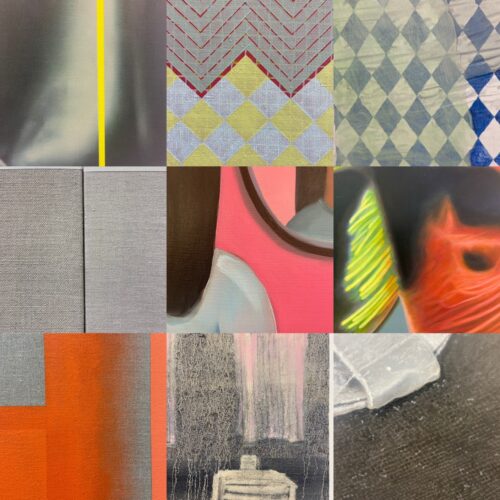
Science and art: Liz is in the mire…
‘Mire’ is the visual outcome of a three year research art/science project by artist and Open College of the Arts Tutor, Liz Douglas. She has been researching diatoms found in pools at Murder Moss, one of the Whitlaw Mosses in the Scottish Borders. Whitlaw Mosses are a National Nature Reserve, a site of special scientific interest and a European protected site.

Liz Douglas, collaborated with the reserve managers, Scottish Natural Heritage, to collect the diatoms; with SEPA (Scottish Environmental Protection Agency) at the cleaning of the samples stage, and with experts at the Royal Botanic Garden,Edinburgh, to image the algae, using a powerful scanning electron microscope, and then to identify the genus of the diatoms found in pools at Murder Moss. An important part of the project was the educational work. Liz worked with school pupils on an Science/Art Curriculum for Excellence project over 6 months, as well as 3D structure making workshops with other schools.The Whitlaw Mosses project was used to provide research material for the workshops. The aim was to encourage students to closely observe their own environment.
The science research was fundamental research in the making of artwork, and gave some understanding of a microscopic, invisible world. The processes that she used to convey a sense of place involved drawing, painting, digital imaging, and walking round the site. The drawings are of mixed media in sketchbooks, on cartridge paper and newsprint. She also used monoprints, acetates, digital imaging and overhead projections in the development of her paintings. The work in the exhibition consisted of a variety of sizes of paintings on canvas and board; a woven paper piece, digitally printed banners on silk; scanning electron microscopic images and closely observed drawings of diatom structures.
The work in the exhibition can be seen here The exhibition ‘Mire’ by Liz Douglas is on at Harestanes, Scottish Borders and runs from April 2, 2011 – May 8, 2011. For more information go to www.scotborders.gov.uk/harestanes






I have found this really interesting as am interested in Science, Environment and Art. Unfortunately, I live in London, so am unable to visit the Scottish Borders at this point and the exhibition. I have been to the Scottish Borders about 11 years ago and a Nature Reserve there.
The link at “here” in the article above doesn’t work because “dot htm” is missing. Try this … http://www.lizdouglas.co.uk/work.htm — it’s a wonderful show, congratulations to Liz who was my tutor for Painting 3 Advanced.
Thanks Mary, now sorted.
Congratulations Liz on producing one of the most beautiful and fascinating series I have seen in a long long time.
Once again an article in the Science and Art series not only manages to introduce readers to the project work of Liz Douglas
and her 3yr artistic collaboration with the Scientific World, but also (whether by default or intention ( analogy )) for me also opens up the possibility of a wider debate on the nature of art in general and the function of the artist.
The fact that all great Art should ‘entertain’ is a point well illustrated by the digital print ‘Another World ‘ which to some extent does manage to achieve this. Our attention as viewers is captured and our curiosity is stimulated as we are drawn into the mysterious world of the Diatom.
Certainly the work does seem to act as a vehicle for ‘the distilled essence of life ‘ and the image does seem to
almost magically widen and intensify our experience of an otherwise unknown yet ‘real’ world – well at a ‘surface level’ it does anyhow!.
The problem here is that whilst our interest is aroused by the artists ‘intriguing ‘topic i.e microscopic algae found in the pools of the Scottish Borders , after a brief while our intial arousal seems to wane and our interest simply slips away to other concerns. And all this seems not to be due to the theme but due to its artistic illustration.
The print in other words fails to maintain our initial curiosity for longer than a micro-second. This for me appears to be because the print is ‘indeed’ a static and ‘surface’ illustration of what would otherwise be a fascinating journey into the world of the unknown – the world of not outer-space but the enclosed world of the biological organism.
Of course it is safe to say that the print does go further than merely providing the viewer with an encyclopedic
or straightforward factual representation of its topic. We are not just being informed or educated into the existence of or the workings of another ulterior or parallel relatively unexplored world to our own here, there is very real moral or artistic insight to be had as we gaze at the ‘digital’ image and our world as we perceive it is no longer the same after viewing this print.
A serious problem as I see it tho’ is that all Art whether it be painting or literature etc has the important function to entertain, to bring enjoyment by stimulating the imagination.
For example literature, painting alike whilst informing us or persuading us should also place great emphasis on ‘how’ something
is said or represented. Both can include facts about real people and actual experiences but really depends on the writers or painters unique imagination.
The problem here is that it really is hard to tell here without viewing the print ‘Another World ‘ in the flesh whether Liz Douglas achieves the basic artistic goal of entertaining the viewer thru’ the artistic creative use of her medium. Again without ‘actually’ seeing the print its hard to make up ones mind. Unfortunately and up until that point, for the moment Liz Douglas’s work remains for me a ‘temporal’ surface illustration
of what is no doubt a permanently fascinating ‘other’ world.
I’m going to comment on Nigel’s observation before his post has a chance to disappear again.
If one imagines the print he’s referring to at its full size of 1.3m x 3.8m printed on silk and possibly fluttering gently over our heads alongside other associated prints, then I’m sure it would be a totally different experience to seeing it on a computer screen at a size of a few square inches!
It would be interesting to see some photographs of the work in situ at the exhibition, since I have an idea that the way the differing elements of the work was presented together would effect how we see each individual part of it.
Thanks for you comment anned. I think you are right that it is difficult to judge work based only on small thumbnails on the computer.
On your point about comments disappearing, I think we owe an explanation. We have proactive and reactive monitoring of comments to prevent spam and ensure comments are not offensive. The proactive monitoring is largely automatic – it detects spam comments and bins them – on Sunday and Monday of this week there were over 500 attempted comments – the vast majority of them promoting porn or online pharmaceuticals. Occasionally the software looking to prevent the comments is unable to tell whether a comment is legitimate and this leads to both false positives and false negatives. Nigel’s comment was removed yesterday and reinstated by a member of the OCA team this morning.